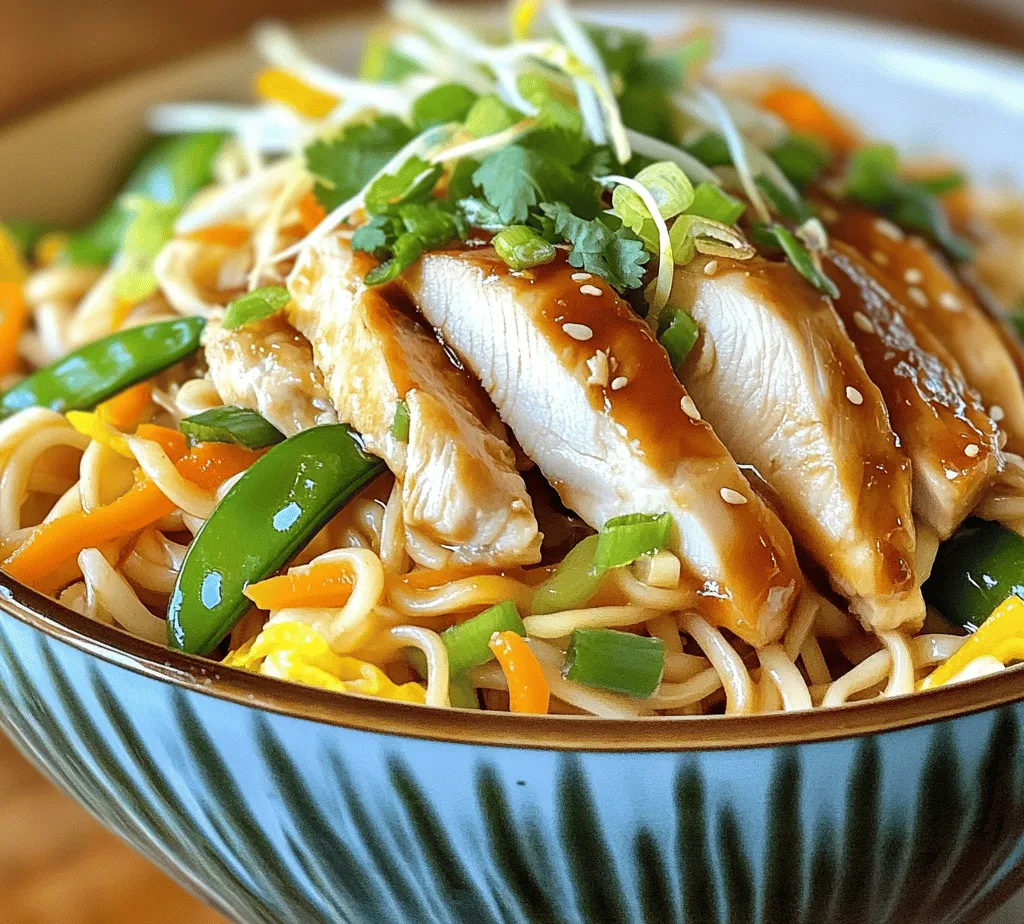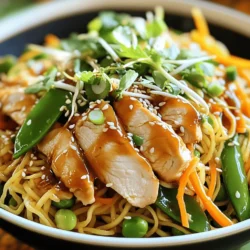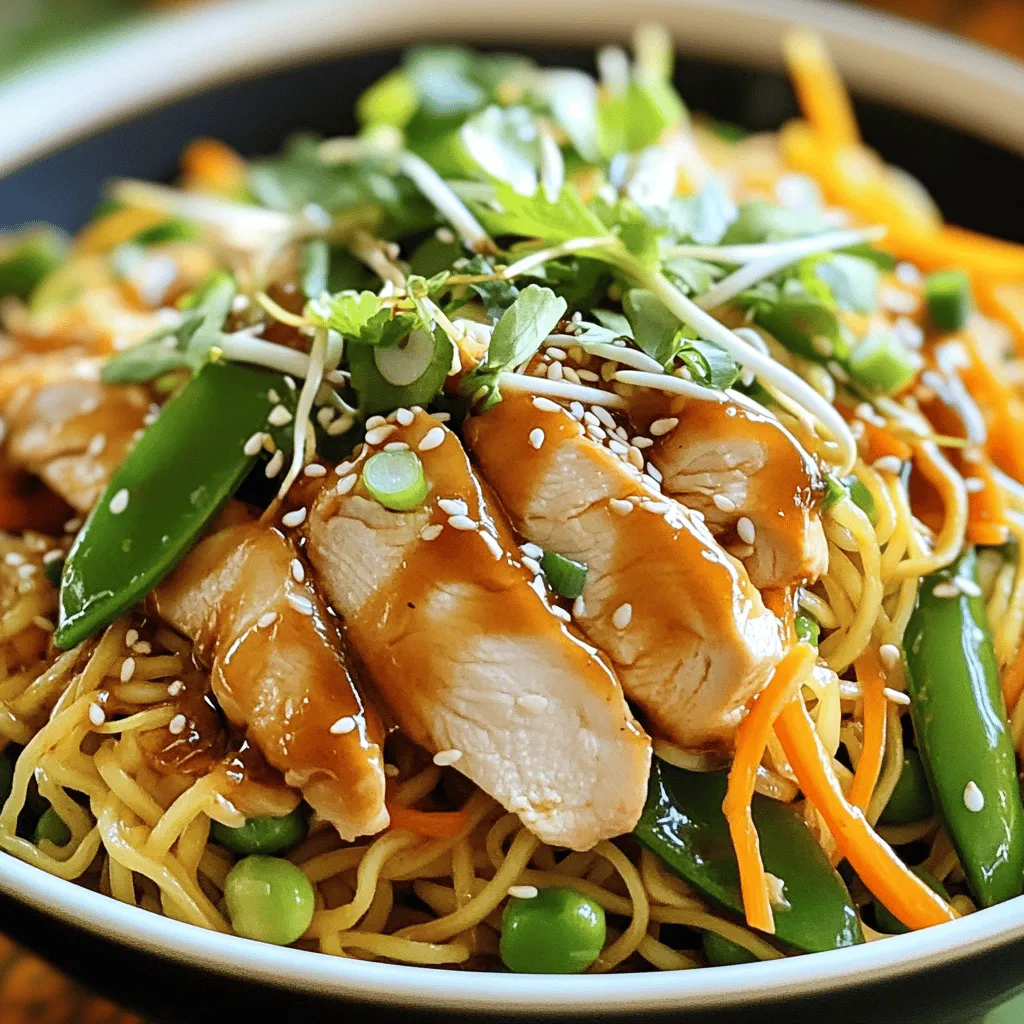Introduction
In the world of comfort food, few dishes are as satisfying as a steaming bowl of Chicken Chow Mein. This classic stir-fry not only tantalizes the taste buds but also brings a sense of warmth and homeliness to the dinner table. Combining tender chicken, vibrant vegetables, and chewy chow mein noodles, all enveloped in a delicious homemade sauce, this dish has become a staple in many households.
Whether you’re whipping up a quick weeknight meal or entertaining friends and family, Chicken Chow Mein is an excellent choice. The best part? It’s quick to prepare, making it a go-to for busy cooks who still want to create something flavorful and nourishing. In this article, we will walk you through a detailed step-by-step guide on how to prepare your own Chicken Chow Mein, ensuring that your next meal is both delicious and easy to make.
Understanding Chow Mein
Exploring the Origins of Chow Mein
Chow Mein, which translates to “stir-fried noodles” in Cantonese, has a rich history that dates back centuries. Although it is widely regarded as a quintessential Chinese dish, the roots of chow mein can be traced to Chinese immigrants who brought their culinary traditions to the United States in the late 19th and early 20th centuries. As these immigrants adapted their recipes to local ingredients, chow mein evolved into various styles, resulting in the dish we know and love today.
The cultural significance of chow mein extends beyond just its taste. It embodies the fusion of flavors and cooking techniques that arise when different cultures intersect. While traditional Chinese chow mein is characterized by its use of fresh vegetables and proteins, Americanized versions often include a greater variety of sauces and toppings, making it a versatile dish that can be tailored to suit diverse palates.
Variations of Chow Mein Around the World
Chow Mein is not just limited to one style; it has numerous variations that reflect regional preferences and available ingredients. For instance, in Hong Kong, you might encounter “Crispy Chow Mein,” where the noodles are fried until golden and crispy before being topped with stir-fried vegetables and meat. Meanwhile, in Indo-Chinese cuisine, you’ll find a spicy rendition of chow mein that incorporates chili sauce, soy sauce, and a medley of spices.
Each variation showcases the adaptability of chow mein, allowing it to be a beloved dish across different cultures. This versatility is part of what makes Chicken Chow Mein such an appealing choice for home cooks—there’s always room for creativity and personalization.
The Components of Chow Mein
Noodles: Types and Textures
The foundation of any great chow mein is, of course, the noodles. Chow mein noodles are typically made from wheat flour and can be found in both fresh and dried forms. Fresh chow mein noodles are soft and have a chewy texture, while dried noodles require cooking before use. When prepared correctly, the noodles should have a delightful balance of tenderness and bite, making them the perfect vehicle for absorbing the flavors of the sauce.
It’s important to note that there are different types of noodles available for chow mein, including thin egg noodles and thicker lo mein varieties. The choice of noodle can greatly influence the overall texture of the dish, so feel free to experiment to discover your favorite.
Typical Ingredients Used in Chow Mein Dishes
Aside from the noodles, Chicken Chow Mein typically includes a colorful array of vegetables such as bell peppers, carrots, bean sprouts, and green onions. These ingredients not only add a crunchy texture but also provide essential vitamins and minerals that contribute to a balanced meal. The combination of vegetables not only enhances the dish’s visual appeal but also adds layers of flavor and nutrition.
Importance of the Sauce in Flavor Development
Perhaps the most crucial element of Chicken Chow Mein is the sauce. A well-prepared sauce elevates the dish, infusing it with bold flavors that complement the chicken and vegetables. Traditional chow mein sauce typically includes soy sauce, oyster sauce, sesame oil, and a touch of sugar for balance. This combination creates a savory, umami-rich sauce that enhances each bite.
By understanding the role of each ingredient in the sauce, you can adjust the flavors to suit your personal taste. For instance, if you prefer a spicier kick, adding a dash of sriracha or chili paste can transform the dish into a zesty delight.
Ingredients Overview
Fresh Ingredients for Chicken Chow Mein
Using fresh ingredients is key to achieving the best results in your Chicken Chow Mein. Fresh vegetables not only retain their nutrients but also provide a vibrant crunch that contrasts beautifully with the chewy noodles and tender chicken. When selecting vegetables, opt for a mix that includes both color and texture—this will enhance the visual appeal of your dish while providing a variety of flavors.
Health Benefits of the Chosen Veggies
The vegetables commonly used in chow mein offer numerous health benefits. For instance, bell peppers are rich in vitamin C, which supports a healthy immune system, while carrots provide beta-carotene, an antioxidant that promotes eye health. Incorporating a variety of vegetables not only enhances the dish’s taste but also boosts its nutritional value, making Chicken Chow Mein a wholesome meal option.
Protein Choices: Why Chicken?
Chicken is the protein of choice for many chow mein recipes, and for good reason. Chicken breast is lean, high in protein, and cooks quickly, making it an ideal ingredient for stir-frying. It absorbs flavors beautifully, ensuring that each bite is packed with taste. Additionally, chicken is versatile, allowing you to customize the dish by adding different seasonings or marinades.
Nutritional Benefits of Chicken Breast
In addition to being a great source of protein, chicken breast is also low in fat and calories, making it a healthy option for those looking to maintain a balanced diet. It is rich in essential nutrients such as niacin and selenium, which play important roles in energy metabolism and immune function, respectively. Incorporating chicken into your chow mein not only enhances flavor but also contributes to a nutritious meal.
Alternatives for a Customized Dish
While chicken is the star of this recipe, there are plenty of alternatives for those seeking variety or following specific dietary preferences. Tofu, shrimp, beef, or even a medley of vegetables can easily be substituted in place of chicken. This adaptability allows you to customize your Chicken Chow Mein to suit your tastes or dietary needs, making it an excellent choice for diverse eaters.
Diving into Chow Mein Sauce
The chow mein sauce is what truly brings this dish to life. Understanding the role of each ingredient in the sauce will empower you to make adjustments based on your personal preferences.
Explanation of Each Ingredient’s Role
1. Soy Sauce: A key component that provides saltiness and umami flavor. It serves as the base of the sauce.
2. Oyster Sauce: Adds depth and sweetness, enhancing the overall flavor profile of the dish.
3. Sesame Oil: A small amount of sesame oil contributes a nutty aroma and richness, elevating the sauce.
4. Sugar: Balances the saltiness of the soy sauce and the richness of the oyster sauce, creating a well-rounded flavor.
5. Cornstarch: Often included to thicken the sauce, providing a silky texture that clings to the noodles and ingredients.
Tips for Adjusting the Sauce to Personal Taste
Feel free to experiment with the sauce to find the perfect balance for your palate. If you prefer a sweeter sauce, you can increase the amount of sugar or add a splash of honey. For a spicier kick, consider incorporating chili sauce or red pepper flakes. The beauty of cooking at home is that you have the freedom to tailor the dish to your liking.
Step-by-Step Cooking Guide
Preparing the Chow Mein Noodles
The first step to crafting the perfect Chicken Chow Mein is preparing the chow mein noodles. Cooking the noodles properly is crucial for achieving the desired texture and preventing clumping.
Cooking Techniques for Perfect Noodles
1. Boil Water: Start by bringing a large pot of water to a rolling boil. Adding salt to the water can enhance the flavor of the noodles.
2. Add Noodles: Once the water is boiling, add the chow mein noodles and cook according to the package instructions until they are al dente.
3. Drain and Rinse: After cooking, drain the noodles and rinse them under cold water. This step halts the cooking process and prevents the noodles from becoming mushy.
Tips for Preventing Clumping
To ensure your chow mein noodles don’t stick together, toss them with a small amount of oil after rinsing. This coats the noodles and keeps them separate, allowing for a perfect stir-fry later on. Additionally, using fresh noodles typically requires less handling, reducing the likelihood of clumping.
With the noodles prepared and ready, you’re one step closer to creating a delicious Chicken Chow Mein that will impress your family and friends. Stay tuned for the next part, where we will dive into the cooking process, combining all the elements to create this satisfying dish.

Crafting the Irresistible Chow Mein Sauce
The key to a delicious Chicken Chow Mein lies in its sauce. A well-crafted chow mein sauce not only enhances the flavor of the chicken but also brings the entire dish together, making every bite a delightful experience.
Detailed Explanation of Sauce Preparation
To create the irresistible chow mein sauce, start with the following ingredients:
– 1/4 cup soy sauce (preferably low-sodium)
– 2 tablespoons oyster sauce
– 1 tablespoon sesame oil
– 1 tablespoon cornstarch (mixed with 2 tablespoons of water, making a slurry)
– 1 tablespoon rice vinegar
– 1 teaspoon sugar
– 1 clove garlic, minced
– 1 teaspoon fresh ginger, minced
Begin by combining the soy sauce, oyster sauce, sesame oil, rice vinegar, sugar, garlic, and ginger in a small bowl. Whisk these ingredients together until they are well blended. This mixture forms the base of your chow mein sauce, providing a balance of salty, sweet, and umami flavors essential to an authentic dish.
Next, bring a small saucepan over medium heat and pour in the sauce mixture. Allow it to simmer gently for about 2-3 minutes, stirring continuously to prevent burning. As it heats, the flavors will meld beautifully. Once the sauce begins to bubble, add the cornstarch slurry to thicken it. Stir until the sauce reaches a glossy consistency, which should take an additional 1-2 minutes. Remove it from the heat and set aside. This sauce can be made ahead of time and stored in the refrigerator for up to a week, making it a convenient option for busy weeknights.
How to Achieve the Right Balance of Flavors
Achieving the right balance in your chow mein sauce is crucial. The soy sauce provides a salty base, while the oyster sauce adds depth and a hint of sweetness. The sesame oil brings a nutty aroma, and the vinegar cuts through the richness, providing a refreshing tang. Adjust the ingredients to your taste; for a sweeter sauce, increase the sugar, or for a spicier kick, add a dash of chili sauce or crushed red pepper flakes. Experimenting will help you find the perfect balance that suits your palate.
Stir-Frying the Chicken to Perfection
Techniques for Tender, Juicy Chicken
When it comes to stir-frying chicken for chow mein, tenderness is key. Start with boneless, skinless chicken breasts or thighs, cut into thin strips. The thinner the slices, the quicker they will cook, ensuring they remain juicy and tender.
Before cooking, marinate the chicken in a mixture of soy sauce, a teaspoon of cornstarch, and a splash of sesame oil for 15-30 minutes. This not only infuses flavor but also helps to tenderize the meat. When it’s time to cook, heat a tablespoon of oil in a large skillet or wok over high heat.
Importance of Cooking Temperature
Cooking at the right temperature is essential for stir-frying. The oil should be hot enough to sizzle when the chicken is added, creating a sear that locks in moisture. Add the marinated chicken to the hot pan in a single layer, being careful not to overcrowd it. This allows the chicken to brown evenly and prevents it from steaming. Stir-fry the chicken for about 3-5 minutes, or until it is cooked through and no longer pink in the center. Remove the chicken from the pan and set it aside. This quick cooking method ensures that the chicken retains its juiciness and is packed with flavor.
Vegetable Stir-Frying Techniques
Best Practices for Preserving Texture and Flavor
The vegetables in your Chicken Chow Mein are just as important as the chicken itself. To preserve their vibrant color and crisp texture, it’s best to use a technique called “flash frying.” This involves cooking the vegetables quickly over high heat.
Choose a mix of colorful vegetables such as bell peppers, carrots, snap peas, and bok choy for a balanced dish. Cut them into uniform sizes for even cooking. Heat another tablespoon of oil in the same skillet or wok, and add the vegetables. Stir-fry them for 2-3 minutes, ensuring they remain slightly crunchy. Season with a pinch of salt and pepper to enhance their natural flavors.
How to Incorporate Seasonal Vegetables
Incorporating seasonal vegetables not only adds freshness but also enhances the nutritional value of your dish. In spring, consider using asparagus and spring onions. In the summer, zucchini and bell peppers shine. For fall, add mushrooms and broccoli, while winter can bring in root vegetables like carrots and turnips. The key is to adapt your recipe to utilize what is freshest and in-season, ensuring maximum flavor and nutrition.
Bringing It All Together
Strategies for Combining Ingredients Effectively
Once your chicken and vegetables are cooked, it’s time to bring everything together. First, return your cooked chicken to the skillet with the vegetables. Pour the prepared chow mein sauce over the mixture, and toss everything together gently. Allow it to cook for an additional 2-3 minutes, letting the sauce coat all the ingredients evenly.
Visual Cues for Doneness and Consistency
As you combine the ingredients, look for visual cues to understand when your Chicken Chow Mein is ready. The sauce should cling to the chicken and vegetables without being too watery. The colors of the vegetables should remain bright, indicating they are cooked but still crisp. The overall dish should be steaming and fragrant, inviting you to dig in.
Serving Suggestions
Presentation Matters
Presentation is key when serving your Chicken Chow Mein. Use a large, shallow bowl or a platter to showcase the vibrant colors of the dish. Garnish with thinly sliced green onions and a sprinkle of sesame seeds for added texture and flavor. For an extra pop, consider adding a few sprigs of fresh cilantro or a wedge of lime on the side.
Best Serving Dishes to Enhance the Meal Experience
Opt for dishes that will enhance the dining experience. A beautiful ceramic bowl can serve as a stunning centerpiece, while individual bowls can allow guests to help themselves. Pair your chow mein with chopsticks for an authentic touch, or offer forks for those who prefer them.
Pairing Options
Suggested Side Dishes and Beverages
To round out your meal, consider pairing your Chicken Chow Mein with a light side dish. A simple cucumber salad dressed with rice vinegar and sesame oil complements the richness of the chow mein. Steamed dumplings or spring rolls can also serve as delicious appetizers.
For beverages, a crisp, cold lager or a fruity white wine like Riesling works wonderfully. If you prefer non-alcoholic options, serve iced green tea or sparkling water with lemon for a refreshing contrast.
How to Make a Complete Meal
With Chicken Chow Mein as the star, your meal can easily become a feast. Add a soup, such as hot and sour or wonton soup, to start the meal. Follow it up with a light dessert, like mango pudding or almond jelly, to cleanse the palate and finish on a sweet note.
Nutritional Information
Caloric Breakdown of Chicken Chow Mein
When prepared with fresh ingredients, Chicken Chow Mein can be a balanced meal option. A typical serving (about 1 cup) contains approximately:
– Calories: 400-500
– Protein: 30g
– Carbohydrates: 50g
– Fat: 15g
This nutritional breakdown can vary based on specific ingredients and portion sizes.
Healthier Alternatives and Substitutions
To make your Chicken Chow Mein healthier, consider using whole wheat noodles instead of traditional chow mein noodles. You can also substitute chicken with tofu for a vegetarian option or reduce the amount of oil used in cooking. Increasing the proportion of vegetables not only enhances nutrition but also adds volume to the dish without significantly increasing calories.
Conclusion
Chicken Chow Mein is not just a meal; it’s a delightful experience combining flavor, nutrition, and ease of preparation. This dish serves as a great weeknight dinner or a crowd-pleaser for gatherings. With fresh ingredients, a homemade sauce, and simple cooking techniques, you can elevate your culinary skills while enjoying a classic comfort food. Whether you’re a seasoned cook or a novice in the kitchen, this Chicken Chow Mein recipe promises to deliver satisfaction in every bite. Embrace the joy of cooking and make this dish a regular feature in your home, bringing the tastes of a cherished favorite to your table.


